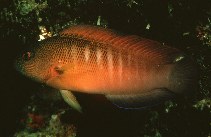| Family: |
Pseudochromidae (Dottybacks), subfamily: Pseudochrominae |
| Max. size: |
23.5 cm TL (male/unsexed) |
| Environment: |
reef-associated; marine; depth range 2 - 20 m |
| Distribution: |
Western Pacific: widely distributed throughout the Indo-Malayan Archipelago, from southern Japan, south to the Northwest Shelf of Australia, and east to New Ireland, Papua New Guinea. |
| Diagnosis: |
Dorsal spines (total): 2-2; Dorsal soft rays (total): 24-26; Anal spines: 3-3; Anal soft rays: 14-15. Lower lip uninterrupted at symphysis. Vomerine teeth relatively large, arranged in a chevron. Caudal fin rounded; upper part with 5 - 6 procurrent rays and 9 principal rays. Lateral line with anterodorsal series of 43 - 62 (usually 48 - 62) tubed scales extending from gill opening, and a peduncular series of 12 - 14 (usually 18 - 22) tubed scales. Dorsal and anal fins with distinct scaly sheaths (Ref. 37748).
Description: Characterized by having variable color; depth of body 31.0-37.8 % of SL (Ref. 90102). |
| Biology: |
Found near shelter of coral or rock of shallow reefs (Ref. 9710), with moderate surge or currents, in spread-out groups of mixed sexes. Also in tidal pools, reef flats and reef slopes, often in relatively silty areas at depths ranging to 20 m (Ref. 81967). Moves about activity through the gutters and passages (Ref. 48635). Feeds on small fishes (Ref. 559). Frequently seen in the aquarium fish trade, and has been bred in captivity (Ref. 35416, 37748). |
| IUCN Red List Status: |
Least Concern (LC); Date assessed: 22 July 2021 Ref. (130435)
|
| Threat to humans: |
harmless |
Source and more info: www.fishbase.org. For personal, classroom, and other internal use only. Not for publication.

